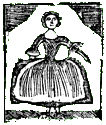As I
described back here, when Gen.
Charles Lee first came to
Cambridge, he and Gen.
George Washington shared the Wadsworth House near
Harvard College for about a week. On 7 July, a
Massachusetts Provincial Congress committee talked with Lee alone about housekeeping needs, suggesting he was about to set up his own quarters.
Lee probably didn’t need much. Since landing in America in October 1773, he had lived as if he were on a permanent campaign, traveling from one colony to another with his dogs, books, and Italian manservant, Guiseppi Minghini.
Lee’s letters in early July came from “Head-Quarters,” and on 20 July he wrote to
Dr. Benjamin Rush from “Cambridge.” Washington split his army into brigades two days later, assigning Lee to command the northern wing.
Lee’s next surviving letter, dated 27 July, went to
Robert Morris from “Winter Hill.” From 12 August to 9 December, he datelined his letters from the “Camp on Winter Hill.” Is that change significant? It might suggest a move closer to camp, or it might mean nothing.
Our best clue about where Lee lived in late 1775 actually comes from after he left Massachusetts to design defenses for
New York. On 19 Feb 1776, Washington wrote to Gen.
John Sullivan, one of Lee’s brigadiers:
I am a little surprizd, and concern’d to hear of your Moving to Colo. [Isaac] Royals House. I thought you knew, that I had made a point of bringing General Lee from thence on Acct. of the distance from his Line of Command, at least that he should not Sleep there. The same reasons holding good with respect to yourself, I should be glad if you could get some place nearer, as I think it too hazardous to trust the left Wing of our Army without a General Officer upon the spot in cases of immergency. I do not wish you to return to your old House, any other tolerably convenient will satisfy me, and I am sure be pleasing to yourself, as I know you would not easily forgive yourself if anything wrong shd. happen for want of your presence on any sudden call.
Unfortunately, there’s no documentation of when Lee moved out of the Royall House in
Medford, or where he moved next. Instead, we have tradition and guesswork.
Lee didn’t help by referring to his quarters only with a facetious nickname. In October, the Rev. Dr.
Jeremy Belknap recorded
hearing about a letter the general had written from “Hobgoblin Hall.” On 10 December, Lee invited
Abigail Adams to dine with him at that “Hobgoblin Hall.” (She declined.) And on 21 Jan 1776, Lee’s other brigadier, Gen.
Nathanael Greene, wrote to him that
Mr. Eustace lodges at Hobgoblin Hall, he says by your Order—should be glad to know your pleasure in the matter.
(Someday I’ll write more about young John Skey Eustace, and what brought him to Cambridge.)
Nineteenth-century authors said that Lee’s “Hobgoblin Hall” was the
Royall House. If so, the general must have continued to use that mansion for work and dinner parties, perhaps because of “the distance from his Line of Command,” but he slept closer to the front. Alternatively, the house where Lee moved
after the Royall House might have been his “Hobgoblin Hall,” and the historians guessed wrong.
That building closer to Winter Hill, nineteenth-century histories said, was the old farmhouse now called the Oliver Tufts House in Somerville. During the Revolution, it was reportedly the home of John Tufts (1754-1839) or his father Peter (1728-1791). The old photograph above shows that building about a century ago, after it had been expanded and moved “a few rods” from its original location. Charles Bahne alerted me to this
new photograph. And here’s a whole
website about the house, based on those later histories.
Similarly, Greene was said to have used the house of Samuel Tufts (1737-1828) as his headquarters. (That man’s wife was, incidentally, a half-sister of little
Joel Adams.)
That building doesn’t survive. I don’t think anyone’s identified where Sullivan lived before he moved into the Royall House so briefly.
I wish I could find contemporaneous documents confirming that the Tufts men arranged for the generals, the Provincial Congress, or the Continental Army to use their houses. But the best information available suggests that Gen. Lee slept in, in turn, the Wadsworth House in Cambridge, the Royall House in Medford, and the Oliver Tufts House in Somerville.










